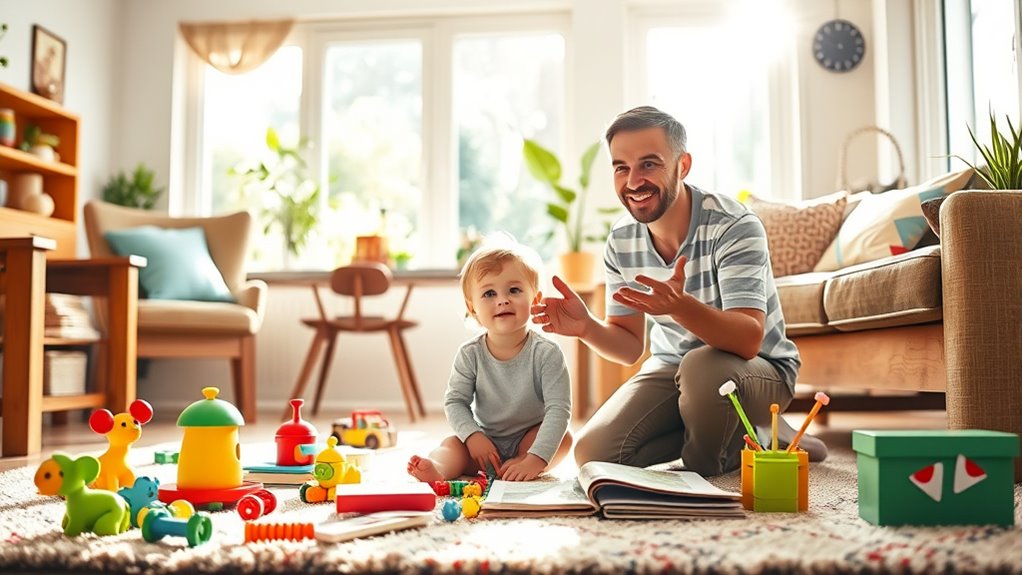When your child says “I’m bored,” view it as a chance to spark their creativity and emotional growth. Ask open-ended questions like “What would you like to create or imagine right now?” or “What adventure should we go on today?” instead of offering immediate entertainment. This encourages independence, problem-solving, and emotional awareness. By responding thoughtfully, you help them turn boredom into a meaningful and inspiring experience—if you continue to explore these strategies, you’ll discover more ways to foster their growth.
Key Takeaways
- Use open-ended questions like “What would you like to create or imagine?” to spark creativity and engagement.
- Validate feelings by asking “Tell me what you’re feeling” to promote emotional awareness.
- Encourage active participation with suggestions such as building, drawing, or inventing to foster independence.
- View boredom as a signal for emotional or creative needs rather than a problem to fix immediately.
- Create a stimulating environment that offers varied activities, helping children explore internally driven interests.

Have you ever wondered how a single phrase can open doors or influence outcomes? When your child says, “I’m bored,” it might seem like a simple complaint, but it’s actually an opportunity to foster creative engagement and develop their emotional intelligence. Instead of dismissing their boredom or offering a quick fix, contemplate using a thoughtful response that encourages them to explore their feelings and tap into their imagination. That’s the power of mastering the magic phrase—knowing what to say to turn a dull moment into a meaningful experience.
When your child declares boredom, your immediate instinct might be to suggest activities or entertain them. However, a more effective approach involves asking open-ended questions or offering gentle prompts that invite them to think creatively. For example, you could say, “What would you like to create or imagine right now?” This encourages your child to consider possibilities rather than passively waiting for entertainment. By doing so, you’re not only fostering creative engagement but also helping them recognize their own capacity to generate ideas and solutions, which is an essential aspect of emotional intelligence.
Using the right words in these moments also teaches your child to manage their feelings. Boredom often masks other emotions like frustration or loneliness, and your response can help them identify and articulate these feelings. When you say, “Tell me what you’re feeling,” or “What kind of adventure would you like to go on today?” you’re validating their emotions while guiding them toward self-awareness. This kind of interaction builds their emotional intelligence, enabling them to understand and regulate their feelings better over time.
The magic phrase isn’t just about avoiding boredom—it’s about transforming it into a chance for growth. Instead of offering instant distractions, you empower your child to see boredom as a signal that they need to engage their mind or heart differently. For example, you could suggest they build a fort, draw a story, or come up with a game. These responses encourage independence, imagination, and problem-solving—all essential elements of creative engagement and emotional development. Over time, your child learns to rely on their inner resources rather than external entertainment, cultivating resilience and a sense of accomplishment.
In addition, creating a structured environment that promotes organization and space maximization can help reduce unnecessary boredom by making sure your child’s environment is stimulating and well-arranged.
In the end, mastering the magic phrase is about more than just saying the right words; it’s about creating a space where your child feels heard, understood, and inspired to explore. By consciously choosing your responses, you teach them valuable life skills and help them develop a positive outlook on boredom—seeing it not as a problem, but as an opportunity for discovery and growth.
Frequently Asked Questions
How Can I Encourage Creativity When Kids Say They’Re Bored?
When kids say they’re bored, you can spark their creativity by offering creative prompts and suggesting artistic outlets. Encourage them to draw, paint, or craft based on a fun theme. Ask open-ended questions that inspire imagination, like “What if you could invent a new animal?” or “Design your dream house.” This approach motivates kids to explore their talents and find joy in creative activities, turning boredom into fun.
What Are Quick Activities for Instant Engagement?
Sure, quick activities are the secret to instant engagement—who knew? You can craft surprise by setting up a mini scavenger hunt or surprise box, or immerse yourself in sensory play with simple items like rice, water, or playdough. These activities spark curiosity and keep kids busy, turning boredom into adventure in minutes. Just grab what’s around, and let the fun begin—because boredom doesn’t stand a chance when surprise is involved!
How Do I Handle Persistent Boredom Over Multiple Days?
When boredom persists over multiple days, you need to address boredom triggers with patience techniques. Talk with your kids to identify what’s causing their boredom, then encourage new routines or creative projects. Stay patient, offering gentle guidance and positive reinforcement. By understanding their feelings and introducing varied activities, you help them develop resilience and curiosity, making it easier to manage ongoing boredom and keep them engaged confidently.
What if My Child Resists Suggested Activities?
When your child resists suggested activities, stay patient and try offering more activity variety. Your parental patience shows you’re flexible and understanding, which encourages them to stay open-minded. Instead of forcing, ask what they’d enjoy or suggest different options. This approach helps them feel heard, reduces resistance, and makes activity time more engaging. Remember, persistence and variety often help kids find something they love, even if they initially resist.
Are There Age-Specific Responses to Boredom?
You should consider age-specific responses to boredom, as developmental considerations influence what activities work best. For younger kids, offer simple, engaging tasks like drawing or building blocks. Older children might enjoy more complex projects or social activities. Tailor your approach to their developmental stage, providing age-appropriate strategies that stimulate their interests and skills. This helps keep them engaged and fosters independence, making boredom less likely to occur.
Conclusion
Now, armed with the magic phrase, you’re ready to turn boredom into adventure. Instead of the usual “What do you want to do?” you say, “Let’s do something fun!” It’s simple, yet powerful—like swapping a dull moment for a spark of excitement. Just like turning a gray sky into sunshine, your words can transform a bored sigh into giggles and discovery. With this phrase, you hold the key to endless possibilities.










